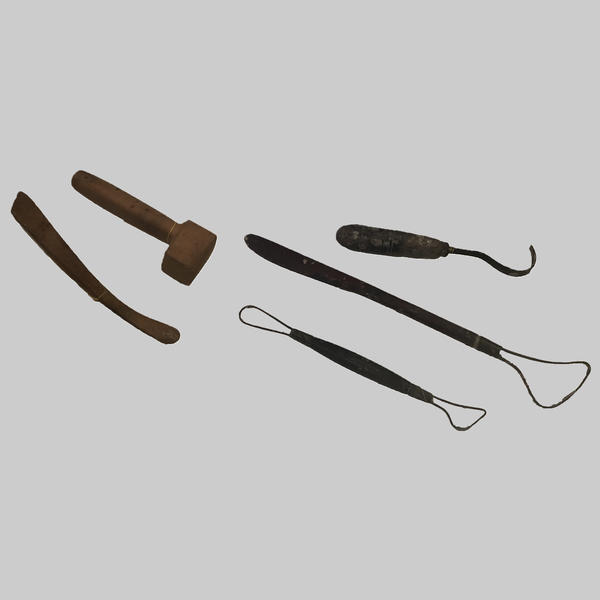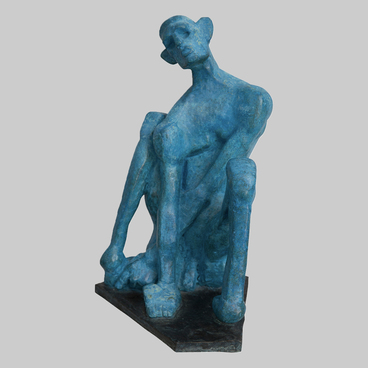These are not dummies or replicas — the show-case displays Ernst Neizvestny’s authentic tools given by the artist to the Museum in 2013. It is these tools that he used working in his studios in New York. They may have been used to sculpt the Golden Child installed in Odessa, Ukraine.
Making a bronze sculpture is a lengthy and labour-consuming process consisting of several stages. The first thing to make is a working model sculpture of any soft material, like clay or plasticine. At this stage, the sculptor translates his ideas into life, experiments, and changes the details.
At this point, he uses modelling tools of various shapes designed to remove, tread and sculpt clay. Single and double wire end tools are used to cut off redundant material. A plaster scraper helps literally “draw” on the surface, making hollows and relieving the necessary elements. Other tools, optional but very useful, include block scrapers, chisels, gouges, cutters, smoothers, and so on.
When a “soft” precursor is ready, it will be coated with silicon rubber or a similar material. It takes rubber about six hours to harden, and then the original sculpture can be easily removed from the mould which is left hollow.
The mold will then be filled with melted wax. It fastens almost immediately, within 10—15 seconds. Bronze is poured into the wax replica, but not immediately. The first thing to do is to connect the pouring gate, the channel for liquid metal. The wax replica is placed in clay or other ceramic material, strengthened with silicon, and the wax melted with hot vapour.
What is left is a solid ceramic mould. It is not ready for bronze pouring yet — the temperature of the liquid metal is about 1140 degrees Celsius and the mould simply cannot resist such heat and will blow up. It needs to be tempered, burned in the kiln at about 850 degrees centigrade.
Melted bronze settles in seconds. But the sculpture is not finished yet. The remaining clay must be removed, all redundant material cut off, the pouring gate taken away, and defects remedied.
The final stage consists in applying a special acid coating to give the sculpture a colour and a thin coat of wax for brightness. Now the sculpture is ready!
Making a bronze sculpture is a lengthy and labour-consuming process consisting of several stages. The first thing to make is a working model sculpture of any soft material, like clay or plasticine. At this stage, the sculptor translates his ideas into life, experiments, and changes the details.
At this point, he uses modelling tools of various shapes designed to remove, tread and sculpt clay. Single and double wire end tools are used to cut off redundant material. A plaster scraper helps literally “draw” on the surface, making hollows and relieving the necessary elements. Other tools, optional but very useful, include block scrapers, chisels, gouges, cutters, smoothers, and so on.
When a “soft” precursor is ready, it will be coated with silicon rubber or a similar material. It takes rubber about six hours to harden, and then the original sculpture can be easily removed from the mould which is left hollow.
The mold will then be filled with melted wax. It fastens almost immediately, within 10—15 seconds. Bronze is poured into the wax replica, but not immediately. The first thing to do is to connect the pouring gate, the channel for liquid metal. The wax replica is placed in clay or other ceramic material, strengthened with silicon, and the wax melted with hot vapour.
What is left is a solid ceramic mould. It is not ready for bronze pouring yet — the temperature of the liquid metal is about 1140 degrees Celsius and the mould simply cannot resist such heat and will blow up. It needs to be tempered, burned in the kiln at about 850 degrees centigrade.
Melted bronze settles in seconds. But the sculpture is not finished yet. The remaining clay must be removed, all redundant material cut off, the pouring gate taken away, and defects remedied.
The final stage consists in applying a special acid coating to give the sculpture a colour and a thin coat of wax for brightness. Now the sculpture is ready!


